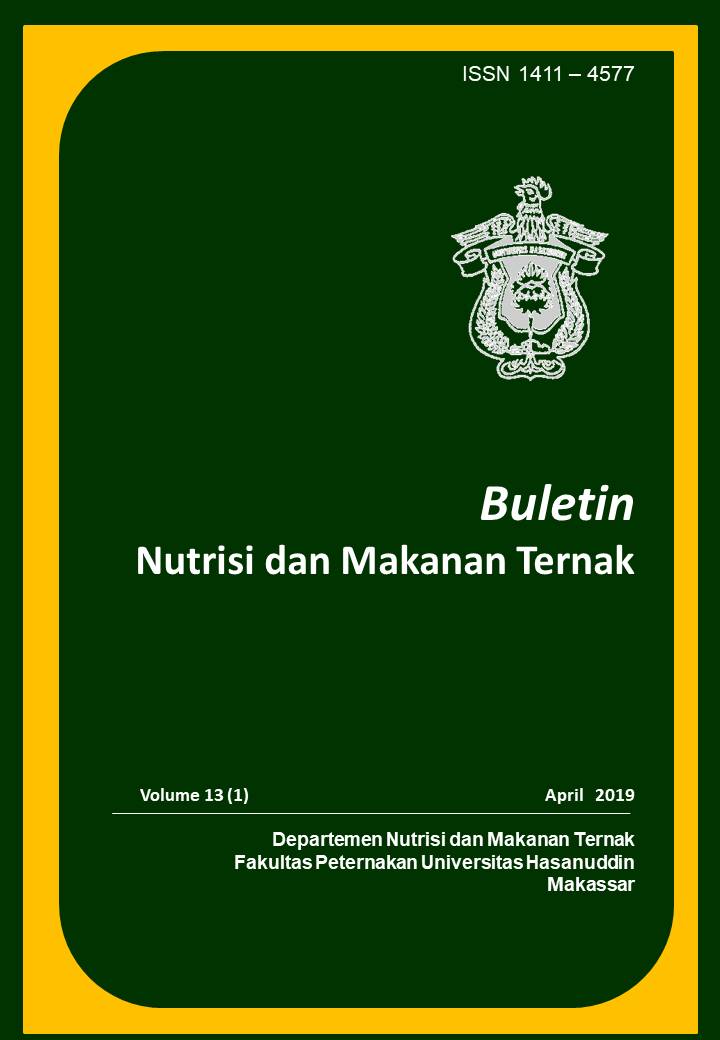Pengaruh Pemberian Molases dan Gula Pasir Terhadap pH dan Produksi Silase Rumput Gajah (Pennisetum purpureun sp).
DOI:
https://doi.org/10.20956/bnmt.v13i1.8188Abstract
Preservation of forage with silage method has been widely practiced by farmers, one of the factors that influence the success of making silage is the addition of additives, such as molasses. However, molasses is not available in all regions. For that we need a material that can be an alternative substitute for silage, namely granulated sugar, besides having nutritional value that is almost the same as molasses, sugar also contains water soluble carbohydrate (WSC) which is easily utilized by lactic acid bacteria as an energy source during the ensilage process. This study aims to determine the effect of molasses and sugar levels on pH values and dry matter of elephant grass silage. The study used a completely randomized design (CRD) with 5 treatments and 3 replications, namely P1: control, P2: Molases 4%, P3: Sugar 4%, P4: Molases 6% and P5: 6% sugar. So that the total sample unit is 15 units and one unit of fresh material samples. Samples were analyzed in the laboratory to determine the pH value and dry matter of silage. The results showed that the administration of sugar additives at the level of 4% in silage had the same quality as silage which was given molasses at the level of 4%. However, at the level of 6% silage which is given molasses it has better quality than silage which is given sugar. This shows that granulated sugar can be used as an alternative to molasses in making silage.Downloads
References
Chen, Y. dan Z. G. Weinberg. 2008. Changes during aerobic exposure of wheat silages. Anim. Feed Sci. Technol. 154:76-82.
Faturrahman, F. Atun, B. dan Tidi, D. 2015. Pengaruh tingkat penambahan molases pada pembuatan silase kulit umbi singkong (Mannihot esculenta) terhadap kandungan bahan kering, bahan organik, dan HCN. Fakultas Peternakan, Universitas Padjadjaran.
Horrocks, R. D. and Vallentine, J. F. 1999. Harvested Forages. Academic Press. New York.
Köhler, B., M. Diepolder, J. Ostertag, S. Thurner, and H. Spiekers. 2013. Dry matter losses of grass, lucerne and maize silages in bun-ker silos. Agric. Food Sci. 22:145–150.
Muck, R.E., and Kung, Jr. L. (2007). Forages : silage production. The Science af Grassland Agriculture. 11(40) : 617-633.
Rahmawati. 2014. Kandungan ADF, NDF selulosa, hemiselulosa dan lignin silase pakan komplit berbahan dasar rumput gajah (Pennisetum pupureum) dan beberapa level biomassa murbei (Morus alba). Skripsi Fakultas Peternakan Universitas Hasanuddin.
Ratnakomala, S., R. Ridwan, G. Kartina dan Y. Widyastuti. 2006. Pengaruh inokulum lactobacillus plantarum 1A-2 dan 1BL-2 terhadap kualitas silase rumput gajah (Pennisetum purpureum). Biodiversitas. 7(2) : 131-134.
Robinson, P. H., N. Swanepoel, J. M. Heguy, and D. M. Meyer. 2016. Total ‘shrink’ losses and where they occur in commercially sized silage piles constructed from mature and immature cereal crops. Sci. Total Environ. 559:45–52
Sadjadi, B. Herlina, dan W. Supendi. 2017. Level penambahan bokashi kotoran sapi terhadap pertumbuhan dan produksi pada panen pertama rumput raja (Pennisetum purpureophiodes). Jurnal Sains Peternakan Indonesia. 12(4): 411-418.
Skerman, P.J. dan F. Riveros. 1990. Tropical Grasses. Food and Agriculture Oerganization. United Nations
Wyss, U. and Rubensuh, U. 2012. Effect of three different silage inoculants on the fermentation quality abd aerobic stability of ryegrass ansiled with three different prewilting degrees. In: kuoppala, K. et al. (eds) Proceedings of the 16thinternational silage conference, 2-4 july, MTT Agrifood Research Finland. University of Helsinki, Hameenlinna, Finland. P. 386-387.





